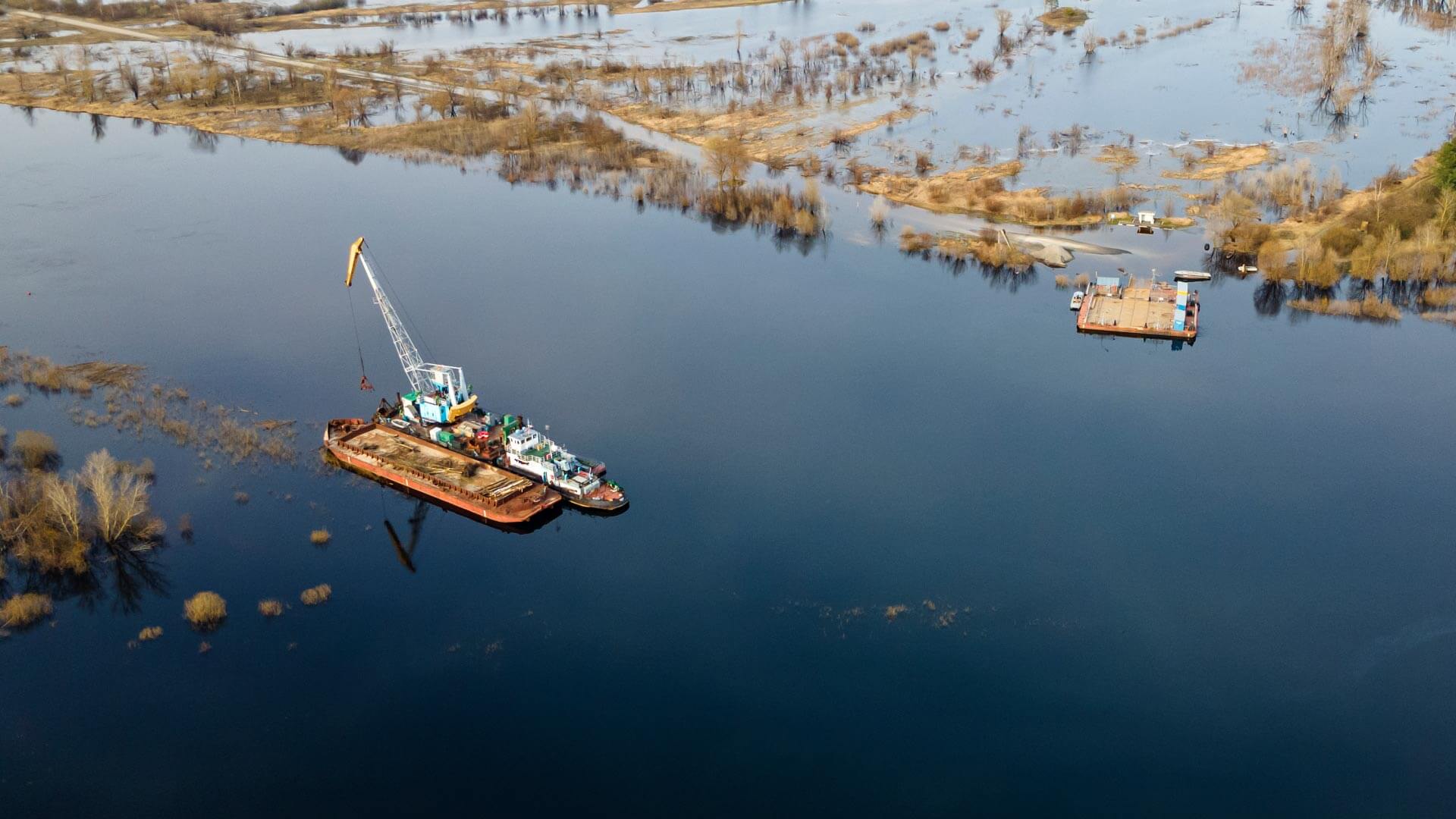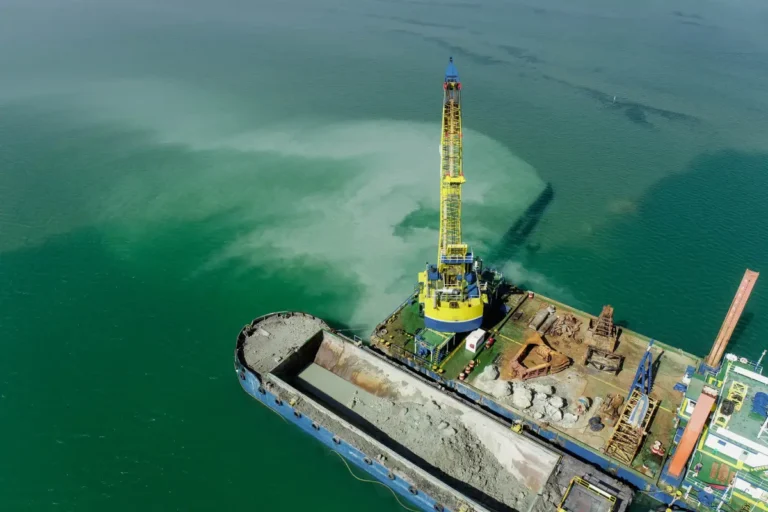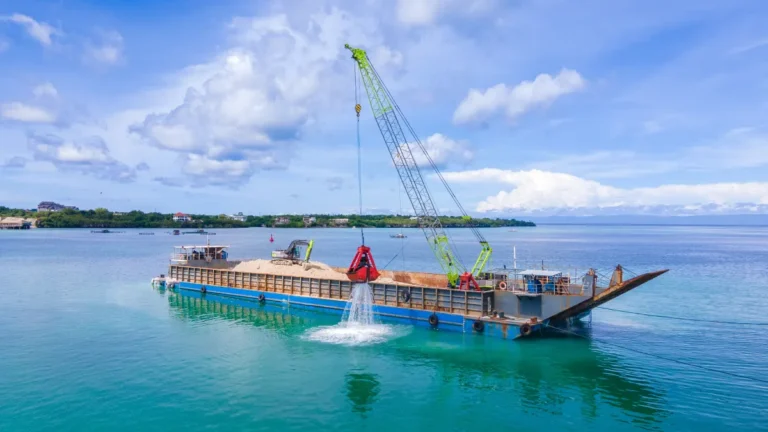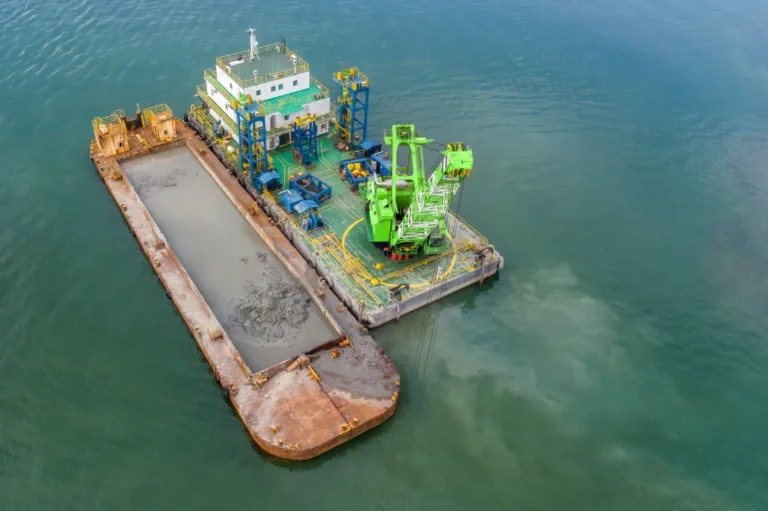Environmental cleanup is a critical component of maintaining healthy ecosystems, supporting biodiversity, and ensuring safe and sustainable waterways. Contaminated sediments, debris, and pollutants can accumulate in rivers, lakes, and coastal areas, causing harm to both the environment and human health. Dredging plays a pivotal role in environmental remediation, offering effective solutions to remove unwanted materials from water bodies.
Among the various dredging techniques, mechanical dredging stands out as a reliable and efficient method. This process involves excavating and removing sediment from the bottom of waterways using equipment like clamshell buckets, backhoes, or draglines. Unlike hydraulic dredging, which relies on pumps and pipelines, mechanical dredging offers distinct advantages in terms of precision and versatility.
The advantages of mechanical dredging make it an excellent choice for projects requiring careful sediment removal in sensitive environments. It is particularly effective in areas with coarse materials, debris, or structures that demand minimal water disturbance. However, like any dredging method, mechanical dredging has its own set of challenges, especially when addressing heavily contaminated sites or fragile ecosystems.
This blog will explore the intricacies of mechanical dredging, delving into its challenges and innovative solutions. We’ll also compare hydraulic and mechanical dredging, helping you understand which method is best suited for specific environmental cleanup projects. By the end, you’ll have a comprehensive view of how mechanical dredging supports environmental restoration and the strategies that enhance its efficiency and sustainability.
Understanding Mechanical Dredging
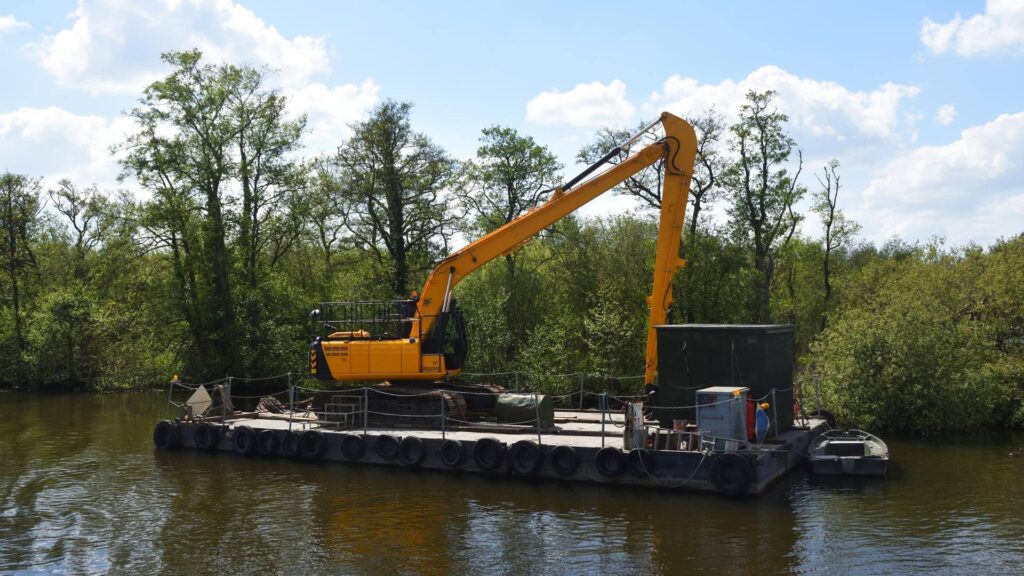
Mechanical dredging is a widely used method for excavating and removing sediments from the bottoms of rivers, lakes, harbors, and other water bodies. This process employs heavy machinery, such as clamshell buckets, backhoes, and draglines, to scoop or lift sediment directly from the waterbed. Unlike hydraulic dredging, which relies on pumping sediments mixed with water, mechanical dredging focuses on targeted excavation with minimal water disturbance.
Overview of the Process and Equipment
The mechanical dredging process begins with the deployment of specialized equipment designed to handle varying sediment types and environmental conditions:
- Clamshell Buckets: These bucket-like tools are ideal for precision dredging, enabling operators to remove sediment layer by layer.
- Backhoes: Mounted on barges or pontoons, backhoes are highly versatile and used for digging in shallow or confined areas.
- Draglines: Known for their long reach, draglines are used for dredging in deeper waters or along steep embankments.
These machines are often mounted on barges or platforms, allowing them to operate efficiently in water bodies of different sizes. Once the sediment is excavated, it is typically transported to a designated disposal site or treated for reuse, depending on project requirements.
Applications in Environmental Cleanup Projects
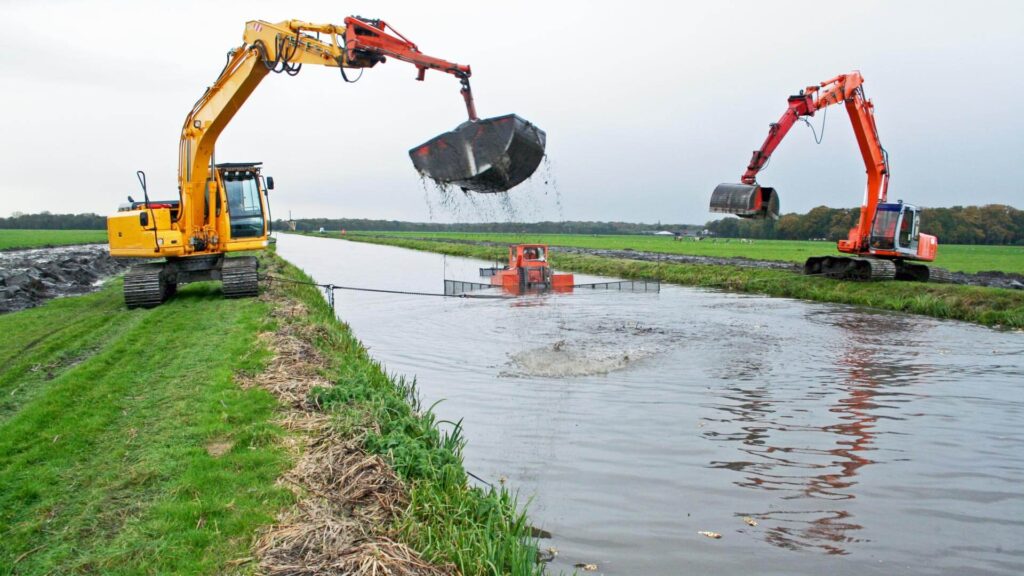
Mechanical dredging is an essential tool for various environmental remediation efforts, offering precise and effective solutions for the following applications:
- Removing Contaminated Sediments: Mechanical dredging excavates polluted material, helping mitigate the risks of toxins leaching into surrounding ecosystems or water supplies. This is especially critical in areas impacted by industrial runoff or chemical spills.
- Restoring Waterways: Accumulated sediments can obstruct waterways, disrupting navigation and water flow. Mechanical dredging clears these blockages, ensuring safe and efficient passage for vessels and improving overall water quality.
- Habitat Rehabilitation: Sediment buildup can degrade aquatic habitats by smothering vegetation or altering the natural landscape. Mechanical dredging restores these environments, allowing native plant and animal species to thrive.
Mechanical dredging’s advantages, such as precision, versatility, and suitability for various sediment types, make it a preferred method in many environmental cleanup scenarios. Its ability to handle debris and coarse materials without excessive water handling sets it apart when evaluating hydraulic vs. mechanical dredging for specific projects.
Advantages of Mechanical Dredging
Mechanical dredging offers numerous benefits that make it an essential method for sediment removal in environmental cleanup projects. Its unique features and capabilities allow it to address complex challenges, often outperforming alternative methods like hydraulic dredging in specific scenarios.
Precise Sediment Removal
One key advantage of mechanical dredging is its ability to provide accurate and targeted sediment removal. Using equipment like clamshell buckets and backhoes, operators can carefully excavate specific areas layer by layer, minimizing disruption to surrounding ecosystems. This precision is particularly important in environmentally sensitive projects or locations with high levels of contamination.
Versatility in Various Environments
Mechanical dredging equipment is highly versatile and designed to adapt to diverse environments. It excels in shallow waters, where hydraulic methods may be less effective, and can operate near structures such as bridges, piers, or seawalls without causing damage. This adaptability ensures that mechanical dredging can be employed in a wide range of conditions, from urban waterways to remote coastal areas.
Minimal Water Disturbance
Compared to hydraulic dredging, which requires mixing sediment with water for pumping, mechanical dredging creates significantly less turbidity. This reduced water disturbance helps protect aquatic life and prevents contaminants from spreading to unaffected areas. Maintaining water clarity during operations is a major advantage, particularly in environmentally sensitive zones.
Efficiency in Handling Coarse Materials or Debris
Mechanical dredging is often the most efficient choice for dealing with coarse sediments, rocks, or debris. Equipment like draglines and clamshell buckets is designed to handle these challenging materials easily, ensuring thorough sediment removal without clogging or interruptions. This makes mechanical dredging ideal for projects involving heavy or dense materials.
Lower Water Management Requirements Post-Dredging
Hydraulic dredging typically requires extensive water management and sediment dewatering after excavation. In contrast, mechanical dredging minimizes the need for such processes, as sediments are removed in a relatively dry state. This reduces the complexity and cost of post-dredging operations, making mechanical dredging a more efficient and cost-effective option in many scenarios.
The advantages of mechanical dredging demonstrate its effectiveness and reliability in various environmental cleanup projects. When comparing hydraulic vs mechanical dredging, the precision, versatility, and reduced water management requirements of mechanical dredging often make it the preferred choice for projects requiring targeted sediment removal and minimal environmental impact.
Mechanical Dredging vs. Hydraulic Dredging
When evaluating dredging methods for environmental cleanup or construction projects, it is essential to understand the distinctions between mechanical and hydraulic dredging. Each method offers unique benefits and is suited for specific conditions, sediment types, and project goals.
Overview of Hydraulic Dredging
Hydraulic dredging involves the use of pumps and pipelines to excavate and transport sediment mixed with water. The process begins with an underwater cutter head or suction device, which loosens the sediment and mixes it with water to create a slurry. This slurry is then pumped through pipelines to a designated disposal or dewatering site.
Hydraulic dredging is typically used for large-scale projects such as deepening navigation channels, beach nourishment, and the removal of fine-grained sediments over extensive areas. Its continuous operation and ability to transport sediment over long distances make it efficient for high-volume projects.
Key Differences in Process, Equipment, and Outcomes
- Process:
- Hydraulic dredging relies on fluidizing sediments into a slurry for pumping.
- Mechanical dredging, on the other hand, excavates sediment directly using equipment like clamshell buckets or backhoes.
- Equipment:
- Hydraulic dredging uses pumps, pipelines, and cutter heads.
- Mechanical dredging employs draglines, backhoes, and barges for sediment removal.
- Outcomes:
- Hydraulic dredging is ideal for large volumes of fine sediments but may require extensive dewatering and sediment management.
- Mechanical dredging offers precise sediment removal and is effective in handling coarse materials or debris.
Factors to Consider When Choosing Between Hydraulic vs Mechanical Dredging
- Environmental Impact:
- Hydraulic dredging creates more turbidity due to sediment mixing, potentially spreading contaminants.
- Mechanical dredging minimizes water disturbance, making it suitable for sensitive ecosystems.
- Type of Sediment and Debris:
- Hydraulic dredging works well with fine-grained sediments like sand and silt.
- Mechanical dredging excels in removing coarse materials, debris, and contaminated sediments.
- Project Size and Timeline:
- Hydraulic dredging is ideal for large-scale projects requiring continuous operation.
- Mechanical dredging is better suited for smaller, precise projects or areas with structural constraints.
- Cost Implications:
- Hydraulic dredging can involve higher initial costs due to pipelines and pumping systems, along with expenses for dewatering.
- Mechanical dredging generally incurs lower costs for equipment setup and sediment handling, especially for localized projects.
Scenarios Where Mechanical Dredging is More Suitable
- Environmental cleanup of contaminated sediments in confined or sensitive areas.
- Projects requiring minimal water disturbance, such as near aquatic habitats.
- Excavation of coarse sediments, rocks, or debris that hydraulic systems may struggle to handle.
- Dredging near structures like bridges, docks, or seawalls where precision is critical.
By understanding the key distinctions and evaluating factors like environmental impact, sediment type, and project scale, stakeholders can make informed decisions about whether mechanical dredging or hydraulic dredging is the best fit for their specific needs. The advantages of mechanical dredging often make it the preferred method for targeted and environmentally sensitive projects.
Challenges in Mechanical Dredging for Environmental Cleanup
While mechanical dredging offers numerous advantages for sediment removal and environmental cleanup, it is not without its challenges. Projects often involve complex ecosystems, strict regulations, and logistical hurdles that require innovative approaches and careful planning.
Navigating Heavily Contaminated or Sensitive Ecosystems
Mechanical dredging is frequently used to remove contaminated sediments from areas with ecological or environmental significance. However, working in these sensitive environments poses risks, including potential harm to aquatic habitats and the unintended spread of pollutants. Balancing precision sediment removal with ecosystem protection is one of the most critical challenges.
Managing Sediment Disposal and Containment
The proper handling and disposal of dredged materials are vital, especially when dealing with contaminated sediments. Mechanical dredging produces solid or semi-solid material that must be transported to secure disposal sites or treated for reuse. Designing and implementing effective containment strategies, such as sediment capping or storage in confined disposal facilities, requires careful coordination and adherence to environmental standards.
Operational Challenges
Several operational factors can complicate mechanical dredging projects, including:
- Weather Conditions: Adverse weather, such as strong winds or heavy rain, can disrupt dredging operations and impact project timelines.
- Shallow Water Operations: Mechanical dredging equipment, such as clamshell buckets and backhoes, may have difficulties in extremely shallow waters, where maneuverability is limited.
- Accessibility Issues: Remote or urbanized locations with restricted access can create logistical barriers for transporting equipment and dredged materials.
Mitigating Risks of Resuspension of Contaminants During Dredging
One key challenge in environmental cleanup using mechanical dredging is minimizing sediment resuspension. Disturbed sediments can release contaminants into the water column, posing risks to aquatic life and downstream areas. Techniques such as silt curtains or real-time turbidity monitoring are essential to mitigate these risks and ensure compliance with environmental standards.
Regulatory Compliance and Community Concerns
Projects involving mechanical dredging must adhere to stringent regulatory frameworks designed to protect water quality and aquatic ecosystems. Navigating these regulations requires detailed environmental impact assessments, permitting processes, and continuous reporting. Additionally, community concerns, such as noise pollution and potential disruption to local activities, must be addressed to build trust and minimize opposition to dredging projects.
While mechanical dredging has advantages, including precision and adaptability, these challenges highlight the importance of planning and implementing best practices to achieve successful outcomes. Comparing hydraulic and mechanical dredging in the context of these challenges can also guide project stakeholders in choosing the most effective dredging method for environmental cleanup efforts.
Solutions to Overcome Mechanical Dredging Challenges
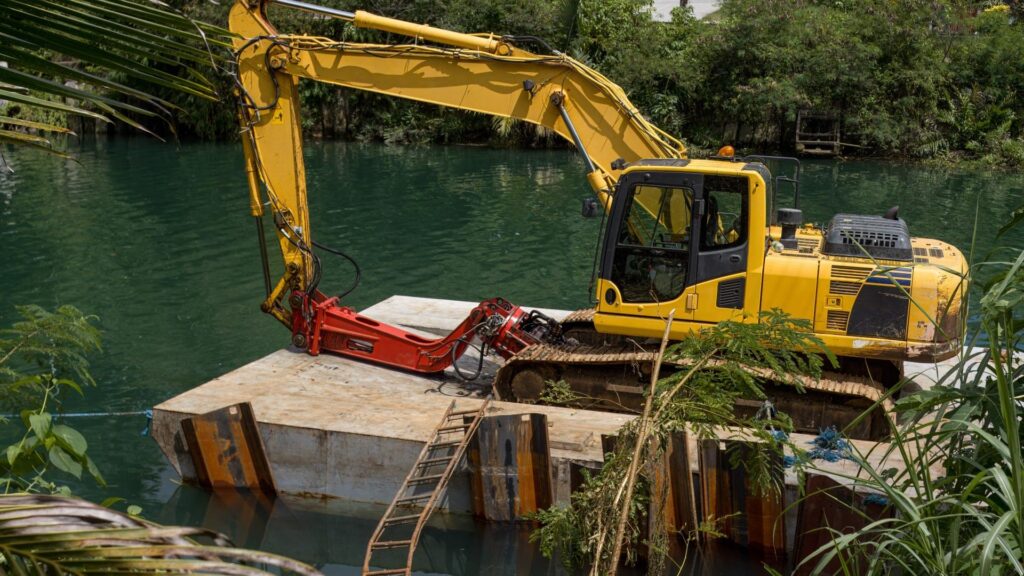
Although mechanical dredging presents unique challenges in environmental cleanup projects, innovative solutions, and best practices have emerged to address these issues. By integrating advanced technology, strategic planning, and sustainable practices, project stakeholders can overcome obstacles while maximizing the advantages of mechanical dredging.
Innovations in Dredging Technology
- Eco-Friendly Dredging Equipment:
Modern mechanical dredging equipment is designed to minimize environmental disruption. Machines with reduced emissions and noise levels are increasingly used to meet regulatory requirements and address community concerns. Precision tools, such as specialized clamshell buckets, further enhance sediment removal accuracy.
- Real-Time Monitoring Systems:
Advanced monitoring systems allow operators to track sediment removal and turbidity levels in real time. These technologies help ensure precision dredging, prevent overexcavation, and mitigate the risk of contaminants resuspending. This level of control is especially valuable in sensitive ecosystems where environmental impact must be minimized.
Best Practices for Minimizing Environmental Impact
- Turbidity Curtains:
Deploying turbidity curtains helps contain disturbed sediments during dredging operations, preventing them from spreading to adjacent water bodies. These barriers are particularly effective in areas with high contamination or delicate aquatic habitats.
- Precision Dredging Techniques:
Techniques such as incremental sediment removal and the use of dredging equipment designed for minimal spillage ensure that only targeted areas are disturbed. This reduces environmental impact and improves project efficiency.
- Controlled Operations:
Scheduling dredging during periods of minimal ecological activity, such as low water flow or off-peak breeding seasons, helps protect aquatic life and enhances overall project sustainability.
Collaborative Project Planning
- Working with Environmental Scientists and Regulatory Agencies:
Collaboration with experts ensures that dredging projects align with environmental goals and comply with regulations. Input from scientists helps identify sensitive areas, while regulatory agencies guide obtaining permits and adhering to standards.
- Community Engagement:
Involving local communities in project planning can address concerns and foster support. Transparent communication about the benefits and measures taken to minimize disruption builds trust and cooperation.
Sustainable Sediment Disposal and Reuse Strategies
- Confined Disposal Facilities (CDFs):
Sediments with contaminants are often stored in secure CDFs to prevent leaching into surrounding areas. These facilities are designed to meet environmental standards and ensure long-term containment.
- Reuse of Dredged Materials:
Sediments can be repurposed for beneficial uses such as land reclamation, construction materials, or habitat restoration. Sustainable reuse reduces disposal costs and maximizes the value of dredged materials.
Future of Mechanical Dredging in Environmental Cleanup
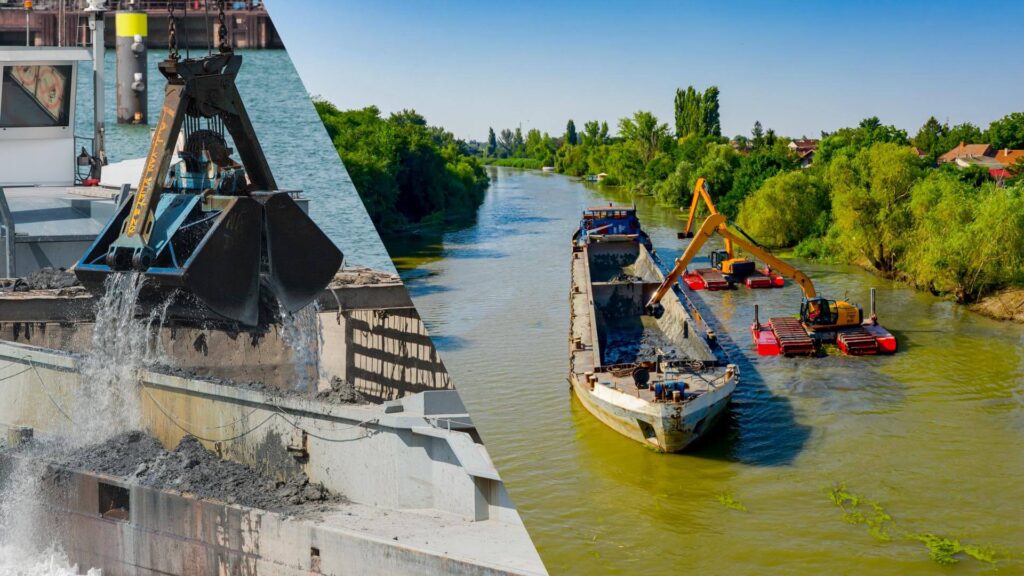
As environmental concerns grow and the need for sustainable practices intensifies, mechanical dredging is poised to play a significant role in addressing global challenges. Advancements in technology, an emphasis on eco-friendly methods, and the strategic importance of dredging in ecological restoration are shaping its future.
Trends in Dredging Technology and Methodology
- Automation and Precision Tools:
The integration of automation and smart technologies is transforming mechanical dredging. Autonomous equipment and GPS-guided systems enable precise sediment removal, reducing environmental disruption and improving efficiency. These advancements ensure that mechanical dredging continues to meet the demands of complex environmental cleanup projects.
- Energy-Efficient Machinery:
Modern dredging equipment is designed to be energy efficient, reducing carbon emissions and operational costs. Hybrid and fully electric dredging machines are emerging as viable options for environmentally conscious projects.
- Real-Time Environmental Monitoring:
The adoption of real-time monitoring systems helps operators track dredging progress and environmental parameters such as turbidity and water quality. This data-driven approach ensures compliance with environmental regulations and minimizes ecological impacts.
Increasing Importance of Sustainable Dredging Practices
- Eco-Friendly Operations:
As sustainability becomes a priority, mechanical dredging is evolving to incorporate practices that protect aquatic ecosystems. Techniques like the use of turbidity curtains, controlled operations, and reduced fuel consumption help minimize the environmental footprint of dredging activities.
- Circular Economy in Dredging:
The reuse of dredged materials is gaining traction as a sustainable solution. Sediments can be repurposed for land reclamation, shoreline restoration, or construction, reducing the need for new raw materials and lowering disposal costs.
- Collaboration for Sustainability:
Partnerships between dredging contractors, environmental scientists, and policymakers are fostering innovative approaches to sustainable dredging. Collaborative efforts ensure that projects align with global environmental goals while addressing local needs.
The Role of Mechanical Dredging in Addressing Global Environmental Challenges
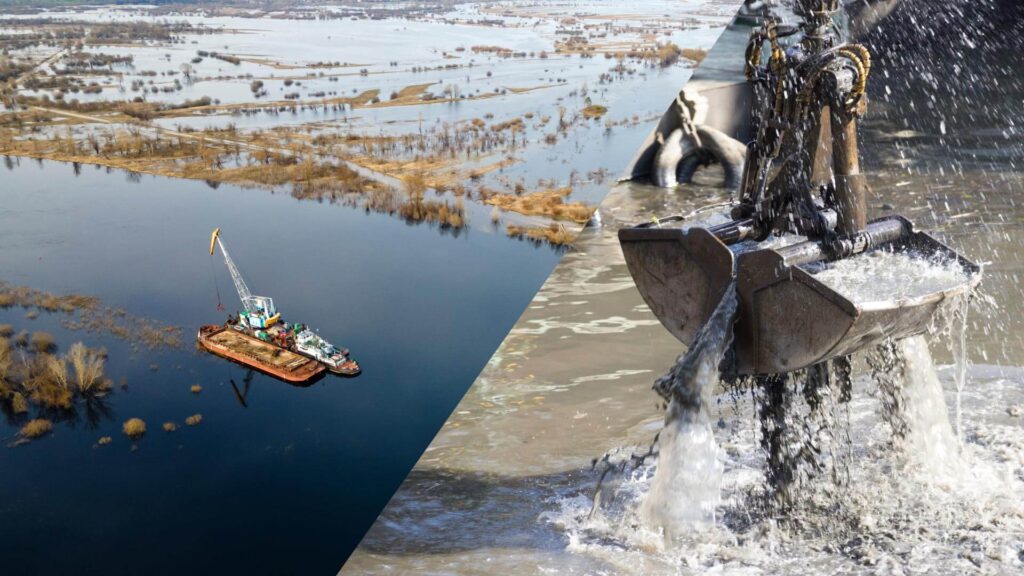
- Restoring Degraded Ecosystems:
Mechanical dredging is essential for restoring waterways affected by sedimentation, pollution, and habitat loss. Removing contaminated or excess sediments supports the recovery of aquatic ecosystems and improves water quality.
- Mitigating Climate Change Impacts:
Rising sea levels and coastal erosion are increasing the demand for dredging to protect vulnerable shorelines and infrastructure. Mechanical dredging’s advantages, such as precision and adaptability, make it a critical tool for these projects.
- Supporting Sustainable Development Goals (SDGs):
Mechanical dredging contributes to global objectives, including clean water, sustainable cities, and climate resilience. When comparing hydraulic vs mechanical dredging, the targeted and environmentally responsible nature of mechanical methods often aligns better with these goals.
Conclusion
Mechanical dredging remains a cornerstone of effective environmental cleanup. It offers distinct advantages, such as precise sediment removal, versatility in challenging environments, minimal water disturbance, and the ability to handle coarse materials or debris. These benefits make it a highly reliable method, especially for projects in sensitive ecosystems or areas requiring targeted sediment removal.
When comparing hydraulic vs mechanical dredging, the choice depends on project-specific factors like sediment type, environmental impact, and operational scale. While hydraulic dredging excels in large-scale, high-volume projects, mechanical dredging is often the preferred option for smaller, more precise operations or those in environmentally fragile zones. Selecting the right dredging method ensures efficiency, cost-effectiveness, and minimal ecological impact.
As the industry evolves, adopting innovative and sustainable solutions is essential to meeting the growing demands of environmental restoration and climate resilience. Industry professionals are encouraged to leverage advancements in eco-friendly equipment, real-time monitoring, and sustainable sediment management practices to address modern challenges effectively. By doing so, mechanical dredging can continue to play a vital role in safeguarding our waterways and ecosystems for future generations.


